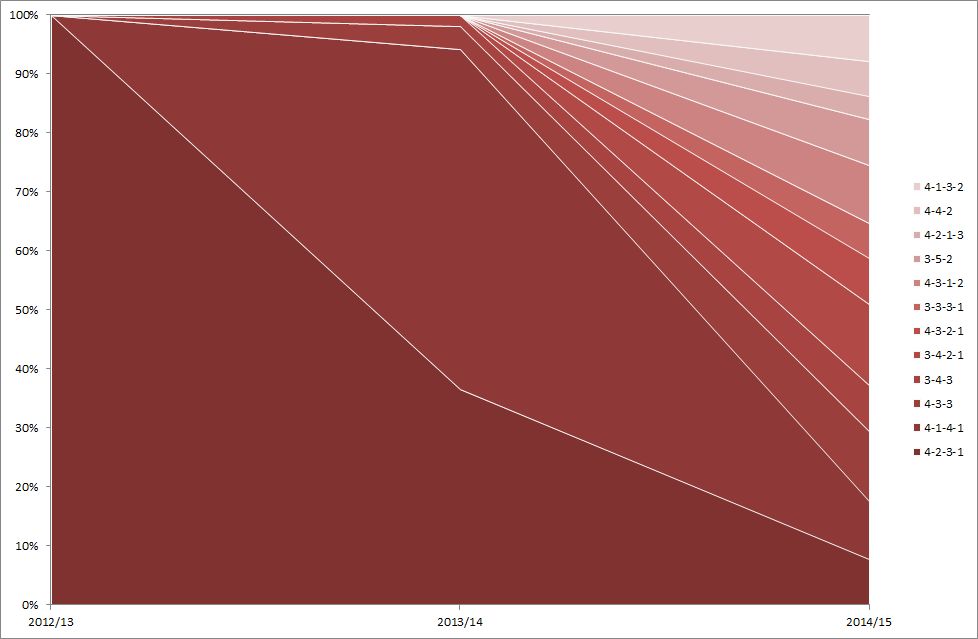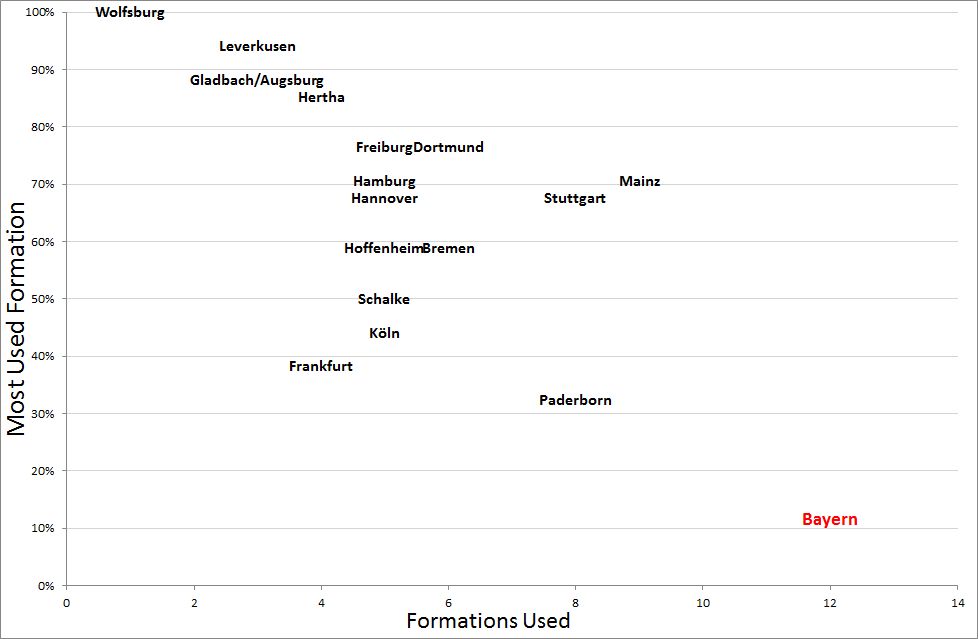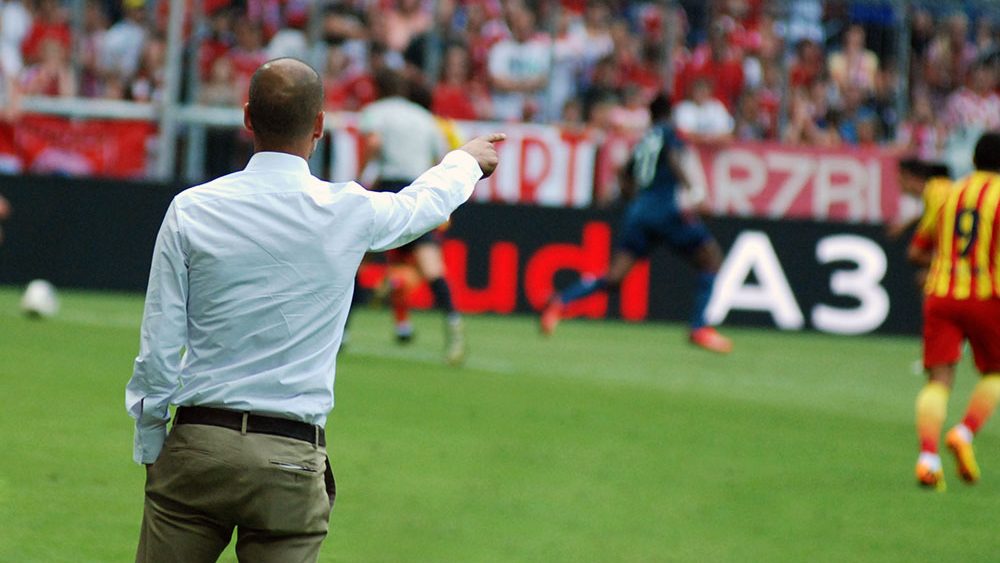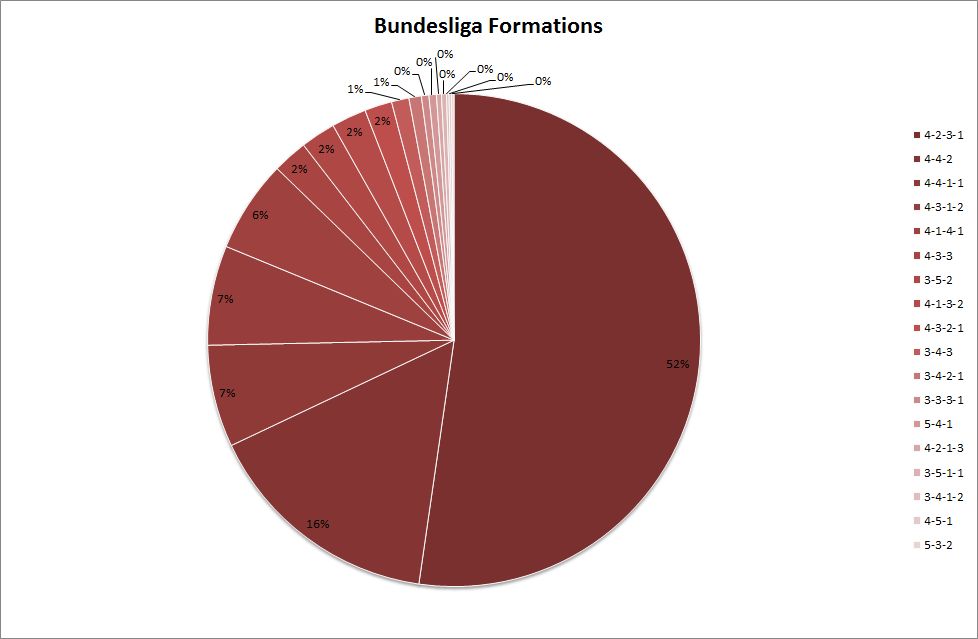Bayern’s Tactical Development Under Guardiola
There are many things about Guardiola’s tenure that can be criticized. Does he get the best out of every player? Surely not, with examples such as Mario Götze being too obvious – that being said, several players have made a huge step forward under Guardiola, Boateng and Alaba in particular. Is he responsible for the historically awful series of injuries? It’s very difficult to judge that without lots of insight and expertise, the numbers certainly aren’t in his favor. Does he bring drama and media attention to the club? Absolutely but not actively, stories are caused not by his actions but by his presence, the drama is purely artificial and based on a fictional reputation that the media and fans convinced themselves of months, if not years ago.
You can have a discussion on all of those things. One piece of criticism, although finally getting rarer by the minute, is completely ridiculous and hardly even deserves to be taken seriously – has Josep Guardiola improved this team tactically?
To spoil our own article, the answer is yes.
 Back in 2012-13, Bayern used only one formation throughout the entire campaign. Two years later, it was already impossible to make a prediction.
Back in 2012-13, Bayern used only one formation throughout the entire campaign. Two years later, it was already impossible to make a prediction.We could end this piece right here but let’s pretend that there are still people out there who think that Guardiola hasn’t done much, that he lacks any backup plan. Let us have a look back at the last few years.
Before he arrived
The Bayern formation under Jupp Heynckes is summed up quickly. Bayern played a 4-2-3-1. Always. In 2012-13, this formation was used 53 out of 53 times in Bundesliga, Champions League and DFB-Pokal. Now of course there were some tweaks that transformed the most ordinary system in German football (in 12-13, the 4-2-3-1 was used more than all other formations combined in the Bundesliga). For example the relatively flexible attacking midfield that saw wingers overload one flank or the adjusting central midfield that brought the division of responsibilities (one vertical, one horizontal) close to perfection.
Generally speaking, opponents knew what was about to hit them. It would be unfair to present it as an inflexible system, Heynckes often made minor adjustments especially in central midfield, but the general idea and setup was known. With Bayern at an efficiency peak, many raised questions if it was sustainable. Every setup is solved eventually and Bayern’s relied a lot on players being in top form both physically and mentally. Driven by the failures of 2012, players like Bastian Schweinsteiger and Philipp Lahm were determined to win everything. It was this mindset that, combined with the aforementioned tweaks, made ultimate success possible. Tactically, Bayern were more than solid but not that dominating. In fairness, this is not a requirement to win the Champions League, as many recent winners have been underwhelming strategically.
Year 1: Keeping his promise
Guardiola arrived in Munich and made a statement that was almost too revealing and dangerous for the time of ridiculous hype: He has to adjust his ideas to the players, not the other way around. This sentenced quickly turned into a benchmark. As expected, it was abused to support an agenda. With the first whiff of vulnerability came the criticism, unloading over the club like a thunderstorm after weeks of violent heat. He had turned a successful machine into a wannabe Barca, failing to deliver on his promise. But did he really?
Of course not. Tactically, this was way closer to 2013 Bayern than to 2009 Barcelona. The entire system was a different one, as Bayern create over the wings while Barcelona did/do it centrally. Beyond that, Guardiola was very careful. The formation was altered minimally, with the main change taking place in central midfield. The team made a logical step, giving up on the clear structure and turning the midfield three into something more fluid. That being said, Heynckes’ trusted midfield of Martinez, Schweinsteiger and Kroos already showed signs of fluidity, as Kroos often fell back while one of Schweinsteiger or Martinez tended to push forward. Guardiola merely continued that trend, he didn’t introduce it.
In terms of numbers, the team was set up in a 4-2-3-1 or an only slightly different 4-1-4-1 in 49 out of 52 matches. Twice, they used a 4-3-3 – again only a minor alteration. The only big exception was the 3-4-3 formation that Guardiola used in the cup final against Dortmund, a decision he was almost forced to make due to an incredible number of injuries.

Carefully moving away from predictability…
Was this part of the learning process and calculated as a necessary step in Guardiola’s 3-year plan or unnecessary conservatism that he felt pressured into? Let’s remember that not only was his initial announcement of adjusting his system to the team twisted into a promise to make no changes at all, the backlash he received after the first test run of the back-three (0-3 in Salzburg) felt to focus less on the failed execution and more on the general idea of that system being outrageous.
Guardiola has been hesitant to agree to transfers purely out of fear that it would be interpreted as yet another dictatorial act of nationalism. Could it be possible that he faced similar worries in his first year at the club? Was he scared of being accused to ruin the club’s identity even more if he made any big changes to the system? Or was it just a case of his players not being ready to execute such concepts properly? In the end, it was probably a bit of both.
Year 2: Let’s get it started
The successful experiment in the cup final was the starting gun. While the result itself wasn’t as clear, the performances of the last men standing (reminder: Rafinha on the left and Højbjerg on the right as wing-backs) was convincing enough to get the media to praise Guardiola’s tactical mind. Changes were now accepted, a back-three no longer outrageous and the full potential of this coach finally unleashed.

The explosion that was 2014-15
Going into the season, Guardiola’s big plan was a back-three with Javi Martinez as central figure. The complete destruction of his knee in the Supercup against Dortmund killed that idea before it was baptized. The bad luck never stopped, with focal points such as Thiago, Lahm, Alaba and Ribery all missing significant time. Guardiola no longer had to be forced to be tactically inventive but the continuous loss of personnel made it a bit more extreme than he would’ve liked. After all, he only got to field the preferred back-three in 35% of competitive matches.

It’s no breaking news but Bayern are unique. Wolfsburg used only one formation throughout the season, Paderborn were desperate enough to be creative.
The difference is simply ridiculous. To remind you, Bayern used only one formation in 2012-13. In 2014-15, the more or less same team used 12 formations. In 34 Bundesliga matches, Bayern used a formation at most four times. The next lowest value was Paderborn who used the same formation eleven times. It has become impossible to predict Bayern’s next formation. And since the changes aren’t just going from a 4-2-3-1 to a 4-1-4-1 or 4-4-2 but cover practically the entire range, Bayern’s system is just as unpredictable. Furthermore, the wing focus is still alive and well, meaning that the team’s main character has survived this constant reinvention.
Influence on the league
Every coach copies. The good ones do it faster, the few crazy ones do it in unforeseen ways, most of them are completely average and do it slowly and carefully. Eventually, more and more Bundesliga coaches will copy this tactical flexibility. As of now, we still see a rather pathetic reliance on the quintessential German system, the 4-2-3-1.
The Bundesliga’s 4-2-3-1 obsession remains but flexibility is slowly becoming more popular.
The real Guardiola effect won’t remain visible at least until the end of the 2015-16 season, and probably not until another one or two seasons after that. That being said, a slight trend is already visible. In 2012-13, Bayern and Dortmund rocked both the league and Europe with a complete focus on a 4-2-3-1 and the entire league followed suit. Three shapes (4-2-3-1, 4-1-4-1 and 4-4-2) made up 88% of the formations used in that Bundesliga campaign.
While that tendency remains due to careful decisions caused by average coaches and conservative management, the variance is growing. Nevertheless, 14 of the 18 clubs used one formation in at least 50% of the matches. And the three exceptions not named Bayern (Frankfurt, Köln and to a certain degree Paderborn) mostly switched back and forth between the good old 4-2-3-1 and 4-4-2. Only Bayern were truly unpredictable. Within three years, this will change. Don’t tell anyone but right now, Bayern might just be the most modern and influential team in football since the Barcelona of half a decade ago. Who coached that team again?















Imo last year pep’s plan got set back due to all those injuries. I hope he extends his contract for two more years. Then, with a bit more luck with injuries, we could see the full potential of this squad.